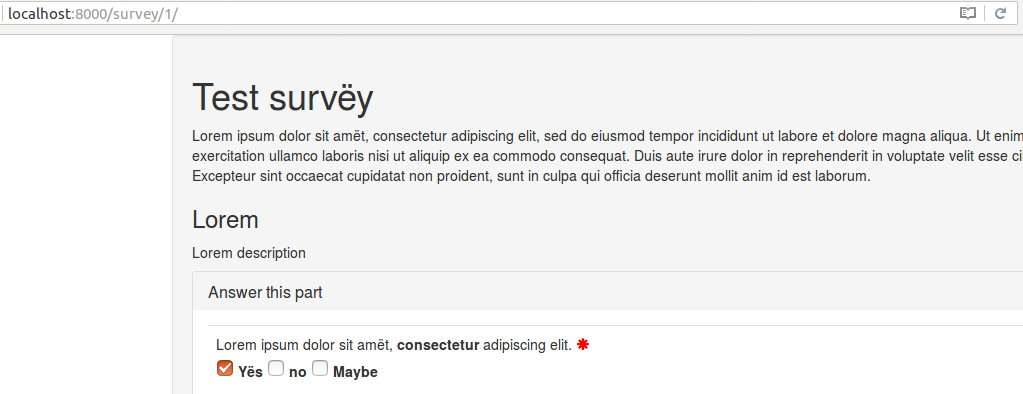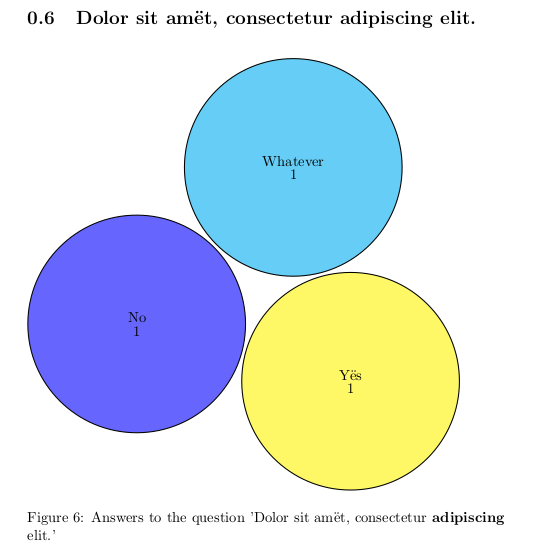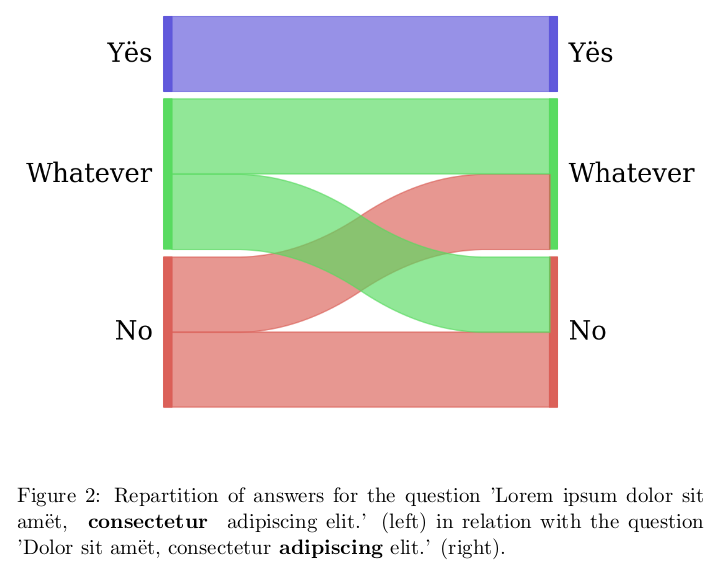A django survey app, based on and compatible with "django-survey". You will be able to migrate your data from an ancient version of django-survey, but it has been ported to python 3 and you can export results as CSV or PDF using your native language.
If you want the latest version still compatible with python 2.7 you need a version < 1.3.0.
- Getting started
- Making a survey
- Generating a pdf report from the survey's result
- Contributing as a developper
- Translating the project
- Credit
Add django-survey-and-report to your requirements and get it with pip.
echo 'django-survey-and-report' > requirements.txt
pip install -r requirements.txtAdd bootstrapform and survey in the INSTALLED_APPS in your settings :
INSTALLED_APPS = [
...
'bootstrapform',
'survey'
]Add an URL entry to your project’s urls.py, for example:
from django.conf import settings
if 'survey' in settings.INSTALLED_APPS:
urlpatterns += [
url(r'^survey/', include('survey.urls'))
]Note: you can use whatever you wish as the URL prefix.
To uninstall django-survey-and-report, simply comment out or remove the
'survey' line in your INSTALLED_APPS.
If you want to use the pdf rendering with the Sankey's diagram generation you will have to install python-tk (for python 2.7) or python3-tk (for python 3.x).
Using the admin interface you can create surveys, add questions, give questions categories, and mark them as required or not. You can define choices for answers using comma separated words.
The front-end survey view then automatically populates based on the questions that have been defined and published in the admin interface. We use bootstrap3 to render them.
Submitted responses can be viewed via the admin backend, in an exported csv or in a pdf generated with latex.
You can manage the way the report is created in a yaml file, globally, survey by survey, or question by question. In order to render pdf you will need to install texlive and python-tk or python3-tk for sankey's diagram.
The results are generated for the server only when needed, but you can force it as a developper with:
python manage.py exportresult -hFollowing is an example of a configuration file. you can generate one with:
python manage.py generatetexconf -hgeneric:
document_option: 11pt
'Test survëy':
document_class: report
questions:
'Lorem ipsum dolor sit amët, <strong> consectetur </strong> adipiscing elit.':
chart:
type: polar
text: pin
'Dolor sit amët, consectetur<strong> adipiscing</strong> elit.':
chart:
type: cloud
text: insideThe pdf is then generated using the very good pgf-pie library.
If you installed python3-tk, you can also show the relation between two questions using a sankey diagram :
'Lorem ipsum dolor sit amët, <strong> consectetur </strong> adipiscing elit.':
chart:
type: sankey
question: 'Dolor sit amët, consectetur<strong> adipiscing</strong> elit.'You get this as a result:
You can also limit the answers shown by cardinality, filter them, group them together and choose the color for each answer or group of answers.
If you use this configuration for the previous question:
'Test survëy':
'Dolor sit amët, consectetur<strong> adipiscing</strong> elit.':
multiple_charts:
'Sub Sub Section with radius=3':
color:
Yës: blue!50
No: red!50
Whatever: red!50!blue!50
radius: 3
'Sub Sub Section with text=pin':
group_together:
Nah:
- No
- Whatever
K.:
- Yës
color:
Nah: blue!33!red!66
K.: blue!50
text: pin
chart:
radius: 1
type: cloud
text: insideYou get this as a result:
If you want to make your own treatment you can use your own class, for example.
Configuration:
'Test survëy':
questions:
'Ipsum dolor sit amët, <strong> consectetur </strong> adipiscing elit.':
chart:
type: survey.tests.exporter.tex.CustomQuestion2TexChildCode in survey.tests.exporter.tex.CustomQuestion2TexChild:
from survey.exporter.tex.question2tex_chart import Question2TexChart
class CustomQuestion2TexChild(Question2TexChart):
def get_results(self):
self.type = "polar"
return """ 2/There were no answer at all,
3/But we have a custom treatment to show some,
2/You can make minor changes too !"""Result:
For a full example of a configuration file look at example_conf.yaml in doc,
you can also generate your configuration file with
python manage.py generatetexconf -h, it will create the default skeleton
for every survey and question.
You may want to use a virtualenv :
python3 -m venv .env/
source .env/bin/activateIn order to get started, install the dev requirements, create the database, create a superuser, load the test dump, then launch the server :
pip install -r requirements_dev.txt
python manage.py migrate
python manage.py createsuperuser
python manage.py loaddata survey/tests/testdump.json
python manage.py runserverpython manage.py test surveycoverage.sh
xdg-open htmlcov/index.htmlisort -rc surveypylint surveyDjango survey's is available in multiple language. Your contribution would be very appreciated if you know a language that is not yet available.
The software is developed in english. Other available languages are :
- French thanks to Pierre Sassoulas
- Japanese thanks to Nobukuni Suzue
- Spanish thanks to Javier Ordóñez
If your language do not exists add it in the LANGUAGE variable in the
settings, like here.
Do not forget to credit yourself like in the header seen
here
Then you can translate with :
python manage.py makemessages
# python manage.py createsuperuser ? (You need to login for rosetta)
python manage.py runserver
# Access http://localhost:8000/admin to login
# Then go to http://localhost:8000/rosetta to translate
python manage.py makemessages --no-obsolete --no-wrap
python manage.py compilemessages
git add survey/locale/
...If your language is not yet available in rosetta, this stack overflow question should work even for language not handled by django.
If you're not a developper, open an issue on github and ask for a .po file in your language. I will generate it for you, so you can edit it with an online editor. I will then create the .po and commit them, so you can edit them with your github account or integrate it myself if you do not have one. You will be credited here.
Based on jessykate's django-survey, and contribution by jibaku, joshualoving, and ijasperyang in forks of jessykate's project.
We use anazalea's pySankey for sankey's diagram during reporting.






